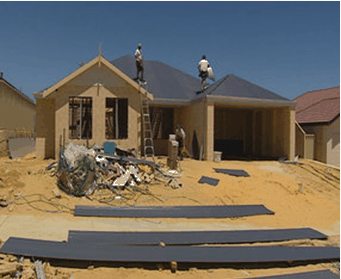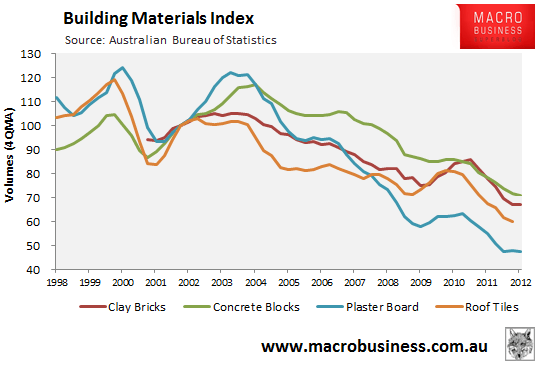
In February, the Australian Bureau of Statistics (ABS) released construction materials volumes data for the December quarter of 2012, which showed continued weakness in the production of concrete blocks, clay bricks, plasterboard, and roof tiles – materials typically used in housing construction.
The Data released by the ABS is not seasonally-adjusted and is highly volatile. Hence it is presented below on a four quarter moving average (4QMA) basis in order to smooth volatility and seasonality:

One company at the forefront of this slowdown in construction materials production is Boral, which has experienced a dismal year.
In April 2012, Boral announced a significant cut to its full year profit guidance on the back of weakening housing activity. Then in January 2013, Boral announced that it would cut 700 jobs. And just last week, the company announced that another 100 jobs would go as falling demand in bricks, roofing and masonry meet high inventory levels and overcapacity in Western Australia and Queensland.
Yesterday, Boral issued its firmest statement yet questioning the conviction of the Reserve Bank of Australia’s (RBA) plan for housing to fill the void left as the mining investment boom unwinds later in the year. From the Age:
Demand for housing has stalled and could even be going backwards despite historically low interest rates, according to one of Australia’s largest building product suppliers Boral, prompting it to slash its profit forecast and flag more job cuts.
Boral chief executive Mike Kane said the Reserve Bank’s recent round of interest rate cuts had done little to bolster demand for housing or for his company’s range of products, including bricks, cement and roof tiles.
‘‘I’ve seen articles suggesting that at these low-level interest rates, house prices should improve,’’ Mr Kane said. ‘‘And we just haven’t seen any green shoots in terms of demand.
‘‘I don’t think it’s improving at all. And as we get through the next quarter we’ll determine whether its going backwards or not – but it’s been stuck for some time.
‘‘The continued weakness in the Victorian market especially suggests that housing demand in Australia is directionally challenged’’.
Replacing mining growth with more houses is increasingly looking like a forlorn hope. First home buyers – a key buyer of house and land packages – have abandoned the market en masse, suggesting they do not want to live in overpriced homes on postage stamp sized blocks on the urban fringe.
The one fix that is required to restore functionality to the market – significantly lower land prices and better funding and provision of housing-related infrastructure – is being ignored by policy makers and developers alike, meaning that sales are likely to continue bouncing around at lower than average levels, despite falling mortgage rates and increased state government and developer incentives.

